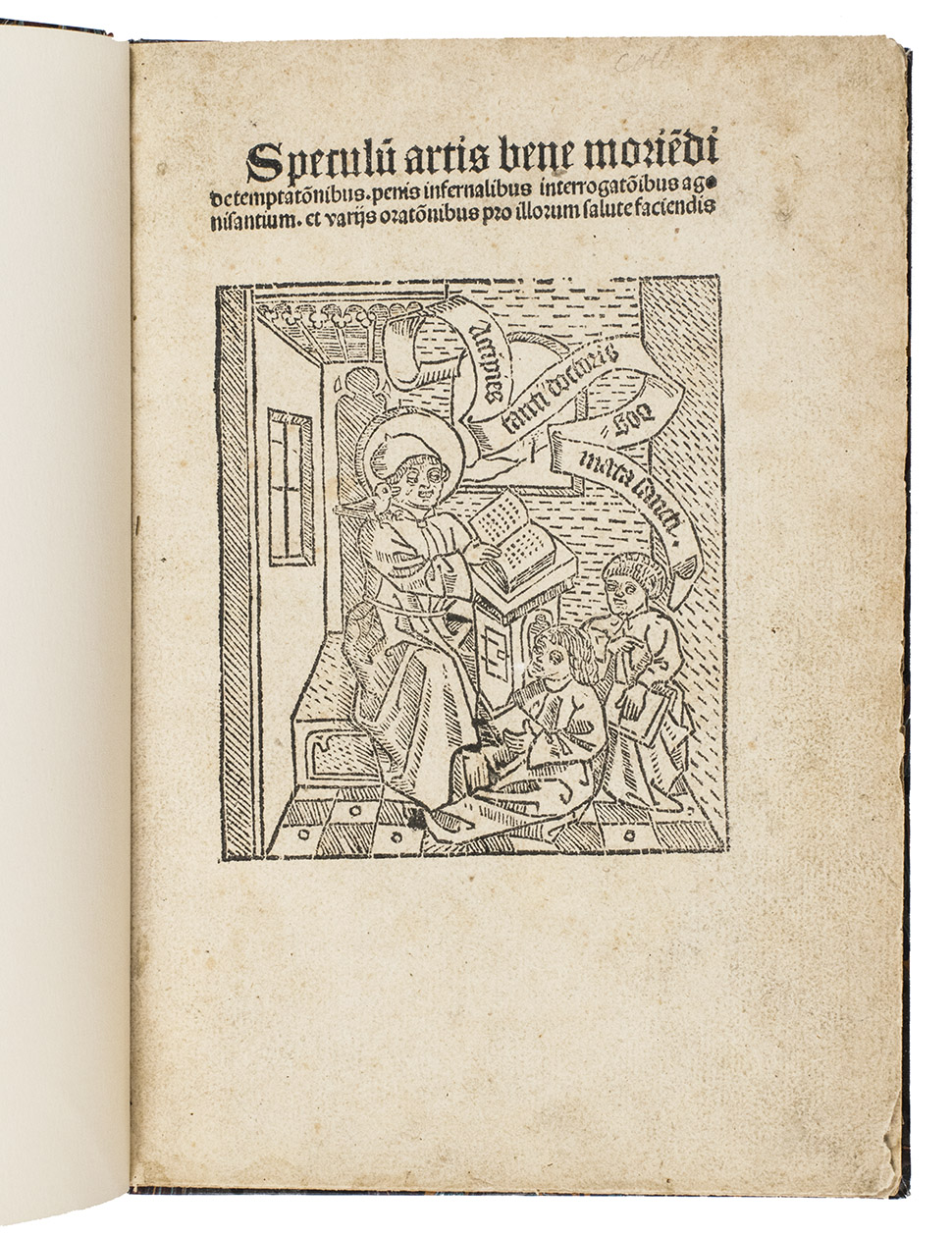[INCUNABLE - COLOGNE EDITION OF THE ARS MORIENDI].
Speculu[m] artis bene morie[n]di [= Ars moriendi].
[Cologne, Heinrich Quentell, ca. 1493/97]. Small (Chancery) 4to (20.5 x 14.5 cm). With a large woodcut (10.0 x 8.8 cm) on the title-page: depicting a teacher (Pope Gregory the Great ca. 600 CE, declared a saint in 1295) with a dove on his shoulder (his attribute), seated behind a lectern with an open book, instructing two of his pupils, seated before him, each with a book in his hands.Recent marbled paper over boards by the Geneva bookbinder Jean-Luc Honegger (b. 1953) who set up his atelier ca. 1978 (signed with his "honegger" stamp in blue ink at the foot of the back paste-down), sewn on 3 recessed supports, the marbled paper in an antique spot pattern (see Wolfe 162-163) with black spots on unusually fine-grained grey Stormont spots and with veins in red, turquoise, orange, dark blue and white, black morocco spine label with the title in gold roman capitals, reading up the spine. [31], [1 blank] pp.
€ 8,500
Quentells second quarto edition of the well-known manual on the art of dying, in the original Latin, matching his ca. 1493 quarto edition almost line for line and using the same woodcut, quite different from any used with this text before that date. Quentells quarto editions contain the original long version of the text, known as Speculum artis bene moriendi, often attributed to Matthaeus de Cracovia or Albertus Magnus (editions in Italian are often attributed to Dominicus de Capranica, Cardinal of Fermo). The Ars moriendi was one of the earliest incunabula printed and consists of two related Latin texts written around 1415 and 1450, offering guidance on how to have a good death according to Christian beliefs of the late Middle Ages. The texts were written in response to the Black Death and social upheavals of the 15th century, with the earliest versions likely composed in southern Germany. The highly populafr Ars moriendi was translated into many West European languages, and was the first in a tradition of guides to death and dying. The first edition in the original Latin appeared ca. 1474, but was preceded by a German edition in 1473 and perhaps by an edition in Italian described as ca. 1471/75. Quentell published the Latin text together with other works in a folio edition described as ca. 1484/89, but he published four quarto editions of the Ars moriendi alone, described as ca. 1493, the present ca. 1495, ca. 1498 and another probably after 1500. He published no Ars moriendi editions in vernacular languages. His first three quarto editions have the same collation, but the present edition matches the ca. 1493 edition almost line for line and uses the same woodcut, while the ca. 1498 edition differs considerably and uses a different woodcut.
Heinrich Quentell, one of the greatest early Cologne printer-publishers, issued many theological and philosophical texts for university use, but also liturgical texts, working both alone and with Johann Helman, who may have also jointly employed contract printers and dispatched servants to sell books. Quentell was one of the first printers to consistently provide his books with title-pages, with approximately 91% of his over 380 publications including one.
Quentell used the present "Magister cum discipulis"-woodcut in several other editions, including the Heymericus de Campo, Promptuarium argumentorum (1492, GW 12406) and Jacobus van Gruitrode, Speculum aureum animae peccatricis (1493, GW M10728). Wynkyn de Worde used a copy in his Parabolarum Alani cum commento (1508, STC 254.3), and other printers copied it as well.
All Quentells Ars moriendi editions are undated and the present one used his types 7 and 10 and initials e, which all apeared in his books in the period 1488 to 1500. The present edition is probably dated ca. 1495 in the literature because it appears to fall between the two quarto editions thought to date from ca. 1493 and ca. 1498.
The bookbinder Jean-Luc Honegger, still active today, is best known for his bindings for the Bibliothèque Nationale de France in Paris and the Bodmer Foundation near Geneva. With the bookplate of the Bibliotheca Philosophia Hermetica (Joost Ritman) in Amsterdam and probably bound for them. Slightly browned, water stains at the foot of a few leaves (not approaching the text), some smudges in the margins and on the blank final page. The binding slightly worn at the extremities and with a few unobtrusive scratches on the back board. Otherwise in very good condition and only slightly trimmed (about 5 mm at the head and probably no more at the fore-edge and foot), giving generous margins (about 2, 3 and 4 cm at the head, fore-edge and foot respectively) and some leaves with tranchefiles at the foot. Bibliothèque Nationale. Catalogue des incunables A-598; BMC I 294.IA 4902; Bod-inc A-449; Bohonos Szandorowska Incunabula quae in bibliothecis Poloniae asservantur 562; Pell 1339; Polain 972; Proctor 1425; Voulliéme Die Buhdrucker Kölns 305; Voulliéme Inkunabeln der Königlichen Bibliothek 1011; Voulliéme Trier 697.
Related Subjects:





